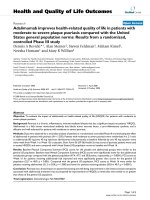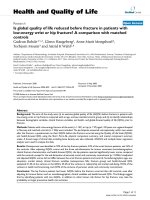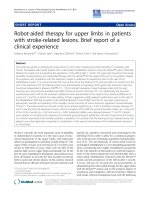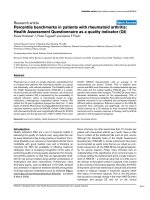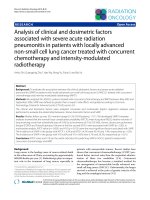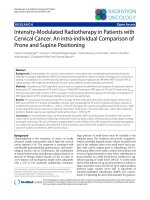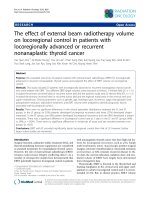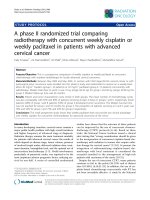Hypofractionated radiotherapy versus conventional radiotherapy in patients with intermediate- to high-risk localized prostate cancer: A meta-analysis of randomized controlled trials
Bạn đang xem bản rút gọn của tài liệu. Xem và tải ngay bản đầy đủ của tài liệu tại đây (1003.02 KB, 8 trang )
Guo et al. BMC Cancer
(2019) 19:1063
/>
RESEARCH ARTICLE
Open Access
Hypofractionated radiotherapy versus
conventional radiotherapy in patients with
intermediate- to high-risk localized prostate
cancer: a meta-analysis of randomized
controlled trials
Wei Guo, Yun-Chuan Sun*, Jian-Qiang Bi, Xin-Ying He and Li Xiao
Abstract
Background: Prostate cancer is one of the most common cancers in the world. The results of treatment after
hypofractionated radiotherapy only have been reported from several small randomized clinical trials. Therefore,
we conducted a meta-analysis to compare clinical outcomes of hypofractionated radiotherapy versus conventional
radiotherapy in the treatment of intermediate- to high-risk localized prostate cancer.
Methods: Relevant studies were identified through searching related databases till August 2018. Hazard ratio (HR) or
risk ratio (RR) with its corresponding 95% confidence interval (CI) was used as pooled statistics for all analyses.
Results: The meta-analysis results showed that overall survival (HR = 1.12, 95% CI: 0.93–1.35, p = 0.219) and prostate
cancer-specific survival (HR = 1.29, 95% CI: 0.42–3.95, p = 0.661) were similar in two groups. The pooled data showed that
biochemical failure was RR = 0.90, 95% CI: 0.76–1.07, p = 0.248. The incidence of acute adverse gastrointestinal events
(grade ≥ 2) was higher in the hypofractionated radiotherapy (RR = 1.70, 95% CI: 1.12–2.56, p = 0.012); conversely, for late
grade ≥ 2 gastrointestinal adverse events, a significant increase in the conventional radiotherapy was found (RR = 0.75,
95% CI: 0.61–0.91, p = 0.003). Acute (RR = 1.01, 95% CI: 0.89–1.15, p = 0.894) and late (RR = 0.98, 95% CI: 0.86–1.10, p =
0.692) genitourinary adverse events (grade ≥ 2) were similar for both treatment groups.
Conclusion: Results suggest that the efficacy and risk for adverse events are comparable for hypofractionated radiotherapy
and conventional radiotherapy in the treatment of intermediate- to high-risk localized prostate cancer.
Keywords: Prostate cancer, Hypofractionated radiotherapy, Conventional radiotherapy, Efficacy, Adverse event
Background
Prostate cancer (PCa) is one of the most common
cancers in the world, especially in North America and
Western Europe [1], with over 50% of patients suffering
from intermediate- to high-risk localized PCa [2, 3]. On
the basis of the results of previous studies, externalbeam radiation therapy (EBRT) combined with androgen
deprivation therapy (ADT) is a standard treatment for
patients with intermediate- to high-risk PCa [4, 5].
* Correspondence:
Department of Radiation Oncology, Hebei Province Cangzhou Hospital of
Integrated Traditional and Western Medicine, Cangzhou 061000, Hebei,
China
Compared with a dose of 75.6 to 79.2Gy for low-risk
patients, doses up to 81Gy in form of conventional fractionation schedules have been recommended for patients
with intermediate- to high-risk PCa [6–8]. However,
conventionally fractionated dose escalation protracts
treatment time, which could possibly increase side effects and yield lower treatment efficacy.
In ideal conditions, radiotherapy dose fractionation
schedules should take into account the sensitivity to
radiation of the tumor relative to nearby non-tumor
tissues. Accumulating evidence shows that the α/β ratio
for PCa is low and range from 0.9 to 2.2 Gy [9]. Radiobiological theory suggests that hypofractionated radiation
© The Author(s). 2019 Open Access This article is distributed under the terms of the Creative Commons Attribution 4.0
International License ( which permits unrestricted use, distribution, and
reproduction in any medium, provided you give appropriate credit to the original author(s) and the source, provide a link to
the Creative Commons license, and indicate if changes were made. The Creative Commons Public Domain Dedication waiver
( applies to the data made available in this article, unless otherwise stated.
Guo et al. BMC Cancer
(2019) 19:1063
schedules applied in fewer fractions and with larger single
doses could increase treatment effects [10]. Further, hypofractionated radiotherapy with single dose≥2.5 Gy per
fraction could theoretically maintain high biologically effective doses, while not increasing acute and late adverse
events, but efficiently shortening the treatment time. Such
outcome would translate into higher treatment capacity
and could potentially reduce treatment cost [11].
The results of treatment after hypofractionated radiotherapy have only been reported from several small
randomized trials [12, 13]. The efficacy and adverse
events of hypofractionated radiotherapy seemed to be
comparable with conventional schedules in the treatment of intermediate- to high-risk PCa. However, small
sample size trials might have biased results, although no
significant effect of publication bias was detected. Lastly,
we pooled the relevant outcomes of randomized trials
and compared the efficacy and adverse events profile of
hypofractionated with those of conventional radiotherapy for intermediate- to high-risk localized PCa.
Methods
Literature search
This meta-analysis was conducted according to Preferred Reporting Items For Systematic Reviews and
Meta-analyses guidelines (PRISMA) [14]. As this metaanalysis was performed based on the published data,
ethics committee and/or institutional board approval
was not required. Our literature search was performed
via Pubmed, Embase and Web of Science databases. The
last search was updated to August 2018. The search
strategy was: “prostatic neoplasms” (MeSH Terms),
“radiotherapy” (MeSH Terms), and “hypofractionated”
(All Fields). At the same time, we also checked abstracts
published in major academic conferences. The references
of studies included were screened to locate potentially
eligible articles.
Study selection
The selected studies should meet the following eligibility
criteria: (1) comparison of the use of hypofractionated
(ie, dose per fraction range from 2.4–4.0 Gy) with that of
conventional radiotherapy (1.8–2.0 Gy per fraction) for
intermediate- to high-risk PCa; (2) clear description of
applied case selection criteria; (3) reported data allows
calculating hazard ratio (HR) or risk ratio (RR) with its
corresponding 95% confidence interval (CI) or alternatively these could be computed according to Tierney’s
method [15]; (4) published as full-text articles; (5) published in English language. The exclusion criteria were:
(1) patients have received previous pelvic radiotherapy
or radical prostatectomy; (2) animal studies; (4) letters,
conference abstracts or review articles.
Page 2 of 8
Data extraction
Two investigators (W.G. And L.X.) independently extracted the following data from the eligible studies using
a predefined protocol: name of the first author, country,
sample size, radiotherapy methods, radiotherapy schedule, androgen deprivation therapy (ADT) and clinical
outcome measures. Discrepancies between the two reviewers were settled by the third investigator (Y.C.S. and
X.Y.H.).
Statistical analysis
HRs and RRs with 95% CIs for clinical outcome measures were directly obtained from each study if available
or were calculated from raw data using the method
reported by Tierney et al. [15]. The Cochran’s Q test
and Higgins I-squared statistic were used to evaluate the
heterogeneity of pooled results. If I2 >50% and P for heterogeneity < 0.1, which show significant heterogeneity,
the random-effect model was used; otherwise, the fixedeffects model was conducted. Sensitivity analyses were
performed to evaluate the impact of individual studies
on the overall estimate. Begg’s funnel plot was assessed
to find publication bias. All data were analyzed through
the STATA 12.0 software (Stata Corp, College Station,
TX, USA). A p-value < 0.05 was considered as statistically significant.
Results
Study characteristics
A total of 416 articles were initially identified. Duplicates
were removed and 364 articles remained. A total of 316
records were excluded after titles and abstracts screening.
Full texts and data integrity were then reviewed, and another 36 papers were excluded. In the end, 12 studies (6
cohorts) [12, 13, 16–25] were included in the final metaanalysis. Our article selection process is shown in Fig. 1.
All the studies included were randomized controlled trials.
Publication years of the records included articles from
2006 to 2017. A total of 2827 patients consisting of 1444
cases treated with hypofractionated radiotherapy and 1383
cases treated with conventional radiotherapy from 6 cohorts were included for this meta-analysis. All patients
suffered from intermediate- to high-risk PCa and did not
receive previous pelvic radiotherapy or radical prostatectomy. Three cohorts were from Italy, one from the USA
and one from Netherlands. The latest study was conducted in 27 centers (14 in Canada, 12 in Australia, and
one in France). The detailed characteristics of the selected
studies are shown in Table 1.
Overall survival, prostate cancer-specific survival and
biochemical failure
Because of homogeneous outcomes of the selected studies (I2 = 0, p = 0.606), the fixed-effect model was applied
Guo et al. BMC Cancer
(2019) 19:1063
Page 3 of 8
Fig. 1 Flow chart of the included trials
Table 1 Study characteristics
Study
Year
Country
n
TNM or risk group
RT
Aluwini et
al
2015–
2016
Most
Netherlands 410 T1b-T4NX-0MX-0
intermediate- to high-risk IMRT
Design
Schedule
ADT Outcomes
Hypofractionated versus
conventional
64.6Gy (19 fractions
within 6.5wks)
Yes
OS, BF
acute and late
adverse events
Yes
OS, BF, PCaSS
acute and late
adverse events
Yes
OS, BF
late adverse
event
Yes
late adverse
event
Yes
acute adverse
event
Yes
BF, PCaSS
acute and late
adverse events
410
Arcangeli
et al
2010–
2017
Italy
83
85
Pollack et
al
2007–
2013
US
78Gy (39 fractions within
8wks)
≥T2c, Gleason ≥7
PSA ≥20ng/ml
high-risk
3D-CRT
Hypofractionated versus
conventional
80Gy (40 fractions of
2Gy, 8wks)
IMRT
154 T1-T3, Gleason ≥5
intermediate- to high-risk
Hypofractionated versus
conventional
153
Marzi et al
2009
Italy
57
57
Strigary et
al
Catton et
al
2009
2017
Italy
Canada
80
70.2Gy (26 fractions of
2.7Gy)
76Gy (38 fractions of
2Gy)
≥T2c, Gleason7-10
PSA>10ng/ml
high-risk
3D-CRT
localized prostate cancer
high-risk
3D-CRT
Hypofractionated versus
conventional
62Gy (20 fractions of
3.1Gy)
80Gy (40 fractions of
2Gy)
Hypofractionated versus
conventional
62Gy (20 fractions of
3.1Gy)
52
56Gy (16 fractions of
3.5Gy)
80
80Gy (40 fractions of
2Gy, 8wks)
608 intermediate-risk
Australia
France
62Gy (20 fractions of
3.1Gy, 5wks)
598
IMRT
Hypofractionated versus
conventional
60Gy (20 fractions of
3Gy)
78Gy (39 fractions of
2Gy)
OS Overall survival, BF Biochemical failure, ADT Androgen deprivation therapy, PCaSS Prostate cancer-specific survival, IMRT Intensity-modulated
radiation therapy, 3D-CRT Three-dimensional conformal radiotherapy, PSA Prostate-specific antigen
Guo et al. BMC Cancer
(2019) 19:1063
for the overall survival (OS) rate. Our results showed
that hypofractionated radiotherapy was not superior to
conventional radiotherapy (HR = 1.12, 95% CI: 0.93–
1.35, p = 0.219, Fig. 2a). The hypofractionated radiotherapy and the conventional radiotherapy of patients
showed no substantial differences in prostate cancerspecific survival analysis (HR = 1.29, 95% CI: 0.42–3.95,
p = 0.661) and showed a high level of heterogeneity
based on the random effect model (I2 = 61.6%, p = 0.106,
Fig. 2b). We used a fixed-effect model to analyze biochemical failure (BF) because there was no statistical
heterogeneity across studies (I2 = 0, p = 0.440), and the
number of patients who were affected by BF was similar
among the two groups (RR = 0.90, 95% CI: 0.76–1.07,
p = 0.248, Fig. 2c).
Page 4 of 8
between groups (p>0.05). Acute genitourinary adverse
events (grade ≥ 2) were similar among the groups (RR =
1.01, 95% CI: 0.89–1.15, p = 0.894, Fig. 3b) with no
heterogeneity (I2 = 0, p = 0.683).
Analysis by the fixed-effect model (I2 = 0, p = 0.826)
showed that conventional radiotherapy significantly increased the grade ≥ 2 late gastrointestinal adverse event
in comparison with the hypofractionated radiotherapy
(RR = 0.75, 95% CI: 0.61–0.91, p = 0.003, Fig. 3c). The
grade ≥ 2 late genitourinary adverse event data were
similar between the hypofractionated radiotherapy and
conventional radiotherapy groups (RR = 0.98, 95% CI:
0.86–1.10, p = 0.692, Fig. 3d) and no heterogeneity was
found for this analysis (I2 = 0, p = 0.496).
Subgroup analysis
Acute and late adverse events
The incidence of grade 2 or worse acute adverse gastrointestinal events were analyzed by the random effect
model due to heterogeneous outcomes (I2 = 67.2%, p =
0.016) and the pooled data revealed a clear rising trend
in the hypofractionated radiotherapy compared with
conventional radiotherapy (RR = 1.70, 95% CI: 1.12–2.56,
p = 0.012, Fig. 3a). However, acute grade ≥ 3 adverse
gastrointestinal events were not significantly different
When we analyzed the subgroup of patients who received
only conventional higher doses of radiotherapy (≥78 Gy)
versus hypofractionated radiotherapy, the incidence of
grade 2 or worse acute adverse gastrointestinal events
were still higher in the hypofractionated radiotherapy
(RR = 1.66, 95% CI: 1.05–2.61, p = 0.029). However, the
other results (OS, BF and genitourinary adverse events
etc.) were not significantly different between the two
groups (all p>0.05).
Fig. 2 Forest plot for overall survival (a), prostate cancer-specific survival (b) and biochemical failure (c)
Guo et al. BMC Cancer
(2019) 19:1063
Page 5 of 8
Fig. 3 Forest plot for acute adverse gastrointestinal event (a), acute genitourinary adverse event (b), late adverse gastrointestinal event (c) and
late adverse genitourinary event (d)
Sensitivity analysis and publication bias
Sensitivity analysis was performed to demonstrate whether
the meta-analysis result was robust. The results of sensitivity analysis were shown in Fig. 4, which revealed that no
individual studies affected the pooled HR or RR significantly, showing a statistically stability result. Begg test
demonstrated no significant statistical evidence of publication bias (p>0.05), which suggested that this meta-analysis
was not significantly affected by publication bias.
Discussion
A large number of clinical studies have suggested that
dose escalation is associated with improved biochemical
and OS outcomes [26–29]. A study of the National Cancer Data Base showed that dose escalation resulted in an
improvement in OS for patients with intermediate- to
high-risk PCa [30]. Kuban et al. [29] published their
dose-escalation study of 301 patients with T1b to T3
PCa. Clinical failure or freedom from biochemical was
superior for patients treated with 78Gy versus 70Gy
(78% vs. 59%, p = 0.004), and the patients with initial
prostate specific antigen (PSA)>10 ng/ml (intermediate- to
high-risk PCa) had a greater benefit (78% vs. 39%, p =
0.001). However, conventionally fractionated dose escalation increased toxicity and overall treatment time. With
improved radiotherapy technologies, hypofractionated
radiotherapy plays a crucial role in the treatment of
intermediate- to high-risk PCa. Several randomized
trials have proved that efficacy and adverse events of
hypofractionated radiotherapy were similar to conventional radiotherapy in most [13, 20] but not all trials
[18]. With aims to provide sufficient evidence for clarifying the discrepancies, the present meta-analysis was
designed to compare clinical outcomes and adverse
events of hypofractionated radiotherapy with conventional radiotherapy for patients with intermediate- to
high-risk PCa with the aim to increase the precision of
the comparisons and the estimate of treatment benefit.
Overall survival is the most important result for any
cancer therapy because it accounts for secondary mortality causes, the interventions used, and all other mortality
causes. Given the indolent nature of the progression of
prostate cancer, long-term follow-up is of particular
importance to assess differences in overall survival [31].
The median follow-up for the selected studies ranges
from 5 to 9 years, and we found that hypofractionated
radiotherapy was not superior to conventional radiotherapy. Although hypofractionated radiotherapy did not significantly improve overall survival, it enhanced biological
efficacy of delivered radiation dose and reduced overall
Guo et al. BMC Cancer
(2019) 19:1063
Page 6 of 8
Fig. 4 Sensitivity analysis of late adverse genitourinary event
treatment time, presumably making the treatment more
acceptable for patients. Biochemical failure was defined
according to the Phoenix definition of nadir PSA plus 2
ng/ml [32]. Although there was no significant difference
in avoiding biochemical failure between the two groups,
there was still a trend in favor of hypofractionated radiotherapy. The α/β ratio for PCa is 1.5Gy from the included studies. After further analysis, we found that the
biologically effective dose (BED) of hypofractionated
radiotherapy was slightly higher compared to conventional radiotherapy. This difference may explain why no
significant difference in biochemical failure was detected
between groups.
Recently, hypofractionated radiotherapy has been introduced as treatment for prostate cancer. Noteworthy,
hypofractionated radiotherapy schedules have a large
variability in the treatment regimens, and the data on
adverse events are sparse. Thus, we pooled the relevant
data and found the incidence of acute adverse gastrointestinal event (grade ≥ 2) was higher in the hypofractionated
radiotherapy; conversely, for late grade ≥ 2 gastrointestinal
adverse events, a significant increase in the conventional
radiotherapy was found. Furthermore, grade ≥ 3 acute
gastrointestinal adverse events in the two groups was not
significantly different, and grade 2 acute gastrointestinal
adverse events were acceptable for patients. The BED for
acute gastrointestinal effect for hypofractionated radiotherapy was significantly greater compared to conventional
radiotherapy in the included trials evaluated for acute
gastrointestinal toxicity (p<0.05). This could be expected
to contribute to the increased acute toxicity with hypofractionated radiotherapy. The reduction in late adverse event
for hypofractionated radiotherapy is consistent with the
linear-quadratic model by Catton et al. [25] that would
predict a lower biologically equivalent dose for normal
tissues with an α/β of 3-5Gy. This finding is further
supported by the trial conducted by Dearnaley et al. [33],
who reported a lower 5-year incidence of grade ≥ 2 gastrointestinal adverse events for both hypofractionated groups
compared to conventional therapy.
Our pooled data showed that Grade ≥ 2 acute and late
genitourinary adverse events were not significantly different between the groups. In 2016, another meta-analysis
from Cao et al. found similar genitourinary adverse events
between hypofractionated and conventional groups [34].
A long-term late adverse event finding from Arcangeli
et al. showed that, a relevant impact did not appear with
high-dose fractions and; significant differences were only
seen for minor (grade 1), late genitourinary adverse events,
namely, for macroscopic hematuria [21].
Our meta-analysis was the first designed to compare clinical outcomes and adverse events between hypofractionated
radiotherapy and conventional radiotherapy for the treatment of intermediate- to high-risk localized PCa. In terms
of efficacy and adverse events, a large number of studies
had tested hypofractionated radiotherapy and found that
effects were compared to conventional radiotherapy in the
treatment of low-risk localized PCa [35–37]. Published
meta-analyses suggest that hypofractionated radiotherapy
could result in comparable therapeutic effects for patients
suffering from localized prostate cancer without increasing
the rate of acute or late adverse events of the gastrointestinal or genitourinary system [38–41]. Our results are in
accordance with these previous findings.
Guo et al. BMC Cancer
(2019) 19:1063
Noteworthy, the current meta-analysis had a number of
limitations. First, the patients included in our metaanalysis were all Caucasian ethnicity. Therefore, the conclusions of this study should be treated with caution when
applied on other ethnic populations. Second, we failed to
analyze the absence of biochemical failure because the
reported data was insufficient. Third, the heterogeneity of
acute gastrointestinal adverse events was relatively large,
which might affect its result.
Page 7 of 8
3.
4.
5.
6.
7.
Conclusion
In summary, meta-analytical data suggest that the efficacy of hypofractionated radiotherapy is comparable to
conventional radiotherapy in the treatment of intermediate- to high-risk localized PCa. Although incidences of
acute gastrointestinal adverse events were found higher
for patients treated with hypofractionated radiotherapy,
hypofractionated radiotherapy was safe with overall acceptable adverse event rates. However, due to the limited
sample of trials that informed this meta-analysis, these
findings should be utilized cautiously when directed in
clinical treatment.
8.
9.
10.
11.
12.
Abbreviations
ADT: Androgen deprivation therapy; BF: Biochemical failure; CI: Confidence
interval; EBRT: External-beam radiation therapy; HR: Hazard ratio; OS: Overall
survival; PCa: Prostate cancer; PRISMA: Preferred Reporting Items For
Systematic Reviews and Meta-analyses; PSA: Prostate specific antigen; RR: Risk
ratio
13.
14.
Acknowledgements
None.
Authors’ contributions
WG and Y-CS designed the research; WG and J-QB performed the experiments; X-YH and LX provided analyzed the data; WG wrote the manuscript.
All authors have read and approved the manuscript and ensure that this is
the case.
15.
Funding
None.
17.
Availability of data and materials
All data are available from the references provided.
16.
18.
Ethics approval and consent to participate
Not applicable.
19.
Consent for publication
All data are based on published research and are subject to copyright
agreements.
20.
Competing interests
The authors declare that they have no competing interests.
21.
Received: 9 May 2019 Accepted: 24 October 2019
22.
References
1. Torre LA, Bray F, Siegel RL, Ferlay J, Lortet-Tieulent J, Jemal A. Global cancer
statistics, 2012. CA Cancer J Clin. 2015;65(2):87–108.
2. Serrano NA, Anscher MS. Favorable vs unfavorable intermediate-risk prostate
cancer: a review of the new classification system and its impact on
treatment recommendations. Oncology (Williston Park). 2016;30(3):229–36.
23.
Thomsen FB, Mikkelsen MK, Hansen RB, et al. Clinical characteristics and
primary management of patients diagnosed with prostate cancer between
2007 and 2013: status from a Danish primary referral center. Acta Oncol.
2016;55(12):1456–60.
D'Amico AV, Chen MH, Renshaw A, Loffredo M, Kantoff PW. Long-term followup of a randomized trial of radiation with or without androgen deprivation
therapy for localized prostate cancer. JAMA. 2015;314(12):1291–3.
Pisansky TM, Hunt D, Gomella LG, et al. Duration of androgen suppression
before radiotherapy for localized prostate cancer: radiation therapy oncology
group randomized clinical trial 9910. J Clin Oncol. 2015;33(4):332–9.
Xu N, Rossi PJ, Jani AB. Toxicity analysis of dose escalation from 75.6 gy to
81.0 gy in prostate cancer. Am J Clin Oncol. 2011;34(1):11–5.
Zelefsky MJ, Levin EJ, Hunt M, et al. Incidence of late rectal and urinary
toxicities after three-dimensional conformal radiotherapy and intensitymodulated radiotherapy for localized prostate cancer. Int J Radiat Oncol Biol
Phys. 2008;70(4):1124–9.
Eade TN, Hanlon AL, Horwitz EM, Buyyounouski MK, Hanks GE, Pollack A.
What dose of external-beam radiation is high enough for prostate cancer?
Int J Radiat Oncol Biol Phys. 2007;68(3):682–9.
Miralbell R, Roberts SA, Zubizarreta E, Hendry JH. Dose-fractionation
sensitivity of prostate cancer deduced from radiotherapy outcomes of 5,969
patients in seven international institutional datasets: alpha/beta = 1.4 (0.9-2.
2) Gy. Int J Radiat Oncol Biol Phys. 2012;82(1):e17–24.
Miles EF, Lee WR. Hypofractionation for prostate cancer: a critical review.
Semin Radiat Oncol. 2008;18(1):41–7.
Kupelian PA, Reddy CA, Klein EA, Willoughby TR. Short-course intensitymodulated radiotherapy (70 GY at 2.5 GY per fraction) for localized prostate
cancer: preliminary results on late toxicity and quality of life. Int J Radiat
Oncol Biol Phys. 2001;51(4):988–93.
Arcangeli G, Fowler J, Gomellini S, et al. Acute and late toxicity in a
randomized trial of conventional versus hypofractionated three-dimensional
conformal radiotherapy for prostate cancer. Int J Radiat Oncol Biol Phys.
2011;79(4):1013–21.
Pollack A, Walker G, Horwitz EM, et al. Randomized trial of
hypofractionated external-beam radiotherapy for prostate cancer. J Clin
Oncol. 2013;31(31):3860–8.
Liberati A, Altman DG, Tetzlaff J, et al. The PRISMA statement for
reporting systematic reviews and meta-analyses of studies that evaluate
health care interventions: explanation and elaboration. Ann Intern Med.
2009;151(4):W65–94.
Tierney JF, Stewart LA, Ghersi D, Burdett S, Sydes MR. Practical methods for
incorporating summary time-to-event data into meta-analysis. Trials. 2007;8:16.
Incrocci L, Wortel RC, Alemayehu WG, et al. Hypofractionated versus
conventionally fractionated radiotherapy for patients with localised prostate
cancer (HYPRO): final efficacy results from a randomised, multicentre, openlabel, phase 3 trial. Lancet Oncol. 2016;17(8):1061–9.
Aluwini S, Pos F, Schimmel E, et al. Hypofractionated versus conventionally
fractionated radiotherapy for patients with prostate cancer (HYPRO): late
toxicity results from a randomised, non-inferiority, phase 3 trial. Lancet
Oncol. 2016;17(4):464–74.
Aluwini S, Pos F, Schimmel E, et al. Hypofractionated versus conventionally
fractionated radiotherapy for patients with prostate cancer (HYPRO): acute
toxicity results from a randomised non-inferiority phase 3 trial. Lancet
Oncol. 2015;16(3):274–83.
Arcangeli G, Saracino B, Gomellini S, et al. A prospective phase III
randomized trial of hypofractionation versus conventional fractionation in
patients with high-risk prostate cancer. Int J Radiat Oncol Biol Phys. 2010;
78(1):11–8.
Arcangeli S, Strigari L, Gomellini S, et al. Updated results and patterns of
failure in a randomized hypofractionation trial for high-risk prostate cancer.
Int J Radiat Oncol Biol Phys. 2012;84(5):1172–8.
Arcangeli G, Saracino B, Arcangeli S, et al. Moderate hypofractionation in
high-risk, organ-confined prostate cancer: final results of a phase III
randomized trial. J Clin Oncol. 2017;35(17):1891–7.
Pollack A, Hanlon AL, Horwitz EM, et al. Dosimetry and preliminary acute toxicity in
the first 100 men treated for prostate cancer on a randomized hypofractionation
dose escalation trial. Int J Radiat Oncol Biol Phys. 2006;64(2):518–26.
Marzi S, Saracino B, Petrongari MG, et al. Modeling of alpha/beta for late
rectal toxicity from a randomized phase II study: conventional versus
hypofractionated scheme for localized prostate cancer. J Exp Clin Cancer
Res. 2009;28:117.
Guo et al. BMC Cancer
(2019) 19:1063
24. Strigari L, Arcangeli G, Arcangeli S, Benassi M. Mathematical model for
evaluating incidence of acute rectal toxicity during conventional or
hypofractionated radiotherapy courses for prostate cancer. Int J Radiat
Oncol Biol Phys. 2009;73(5):1454–60.
25. Catton CN, Lukka H, Gu CS, et al. Randomized trial of a Hypofractionated
radiation regimen for the treatment of localized prostate cancer. J Clin
Oncol. 2017;35(17):1884–90.
26. Peeters ST, Heemsbergen WD, Koper PC, et al. Dose-response in
radiotherapy for localized prostate cancer: results of the Dutch multicenter
randomized phase III trial comparing 68 Gy of radiotherapy with 78 Gy. J
Clin Oncol. 2006;24(13):1990–6.
27. Dearnaley DP, Jovic G, Syndikus I, et al. Escalated-dose versus control-dose
conformal radiotherapy for prostate cancer: long-term results from the MRC
RT01 randomised controlled trial. Lancet Oncol. 2014;15(4):464–73.
28. Denham JW, Steigler A, Joseph D, et al. Radiation dose escalation or longer
androgen suppression for locally advanced prostate cancer? Data from the
TROG 03.04 RADAR trial. Radiother Oncol. 2015;115(3):301–7.
29. Kuban DA, Tucker SL, Dong L, et al. Long-term results of the M. D.
Anderson randomized dose-escalation trial for prostate cancer. Int J Radiat
Oncol Biol Phys. 2008;70(1):67–74.
30. Kalbasi A, Li J, Berman A, et al. Dose-escalated irradiation and overall
survival in men with nonmetastatic prostate cancer. JAMA Oncol. 2015;1(7):
897–906.
31. Morgan SC, Waldron TS, Eapen L, et al. Adjuvant radiotherapy following
radical prostatectomy for pathologic T3 or margin-positive prostate cancer:
a systematic review and meta-analysis. Radiother Oncol. 2008;88(1):1–9.
32. Roach M 3rd, Hanks G, Thames H Jr, et al. Defining biochemical failure
following radiotherapy with or without hormonal therapy in men with
clinically localized prostate cancer: recommendations of the RTOGASTRO Phoenix consensus conference. Int J Radiat Oncol Biol Phys.
2006;65(4):965–74.
33. Dearnaley D, Syndikus I, Mossop H, et al. Conventional versus
hypofractionated high-dose intensity-modulated radiotherapy for prostate
cancer: 5-year outcomes of the randomised, non-inferiority, phase 3 CHHiP
trial. Lancet Oncol. 2016;17(8):1047–60.
34. Cao L, Yang YJ, Li ZW, et al. Moderate hypofractionated radiotherapy is
more effective and safe for localized prostate cancer patients: a metaanalysis. Oncotarget. 2017;8(2):2647–58.
35. Valeriani M, et al. Image-guided hypofractionated radiotherapy in low-risk
prostate cancer patients. J Biomed Biotechnol. 2014;2014:465175.
36. Valeriani M, et al. Moderate hypofractionation in patients with low-risk
prostate cancer: long-term outcomes. Anticancer Res. 2018;38.3:1671.
37. Bruner DW, et al. Quality of life in patients with low-risk prostate cancer
treated with hypofractionated vs conventional radiotherapy: a phase 3
randomized clinical trial. JAMA Oncol, Epub ahead of print. 2019.
38. Yin ZZ, You JQ, Wang YY, et al. Moderate hypofractionated radiotherapy vs
conventional fractionated radiotherapy in localized prostate cancer: a
systemic review and meta-analysis from phase III randomized trials. Onco
Targets Ther. 2019;12:1259–68.
39. Carvalho ÍT, Baccaglini W, Claros OR, et al. Genitourinary and gastrointestinal
toxicity among patients with localized prostate cancer treated with
conventional versus moderately hypofractionated radiation therapy:
systematic review and meta-analysis. Acta Oncol. 2018;57(8):1003–10.
40. Sánchez-Gómez LM, Polo-deSantos M, Rodríguez-Melcón JI, et al.
Hypofractionated radiation therapy versus conventional radiation therapy in
prostate cancer: a systematic review of its safety and efficacy. Actas Urol
Esp. 2015;39(6):367–74.
41. Botrel TE, Clark O, Pompeo AC, et al. Hypofractionated external-beam
radiation therapy (HEBRT) versus conventional external-beam radiation
(CEBRT) in patients with localized prostate cancer: a systematic review and
meta-analysis. Core Evid. 2013;8:1–13.
Publisher’s Note
Springer Nature remains neutral with regard to jurisdictional claims in
published maps and institutional affiliations.
Page 8 of 8
